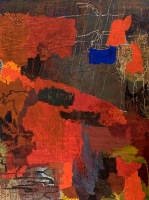 Per Kirkeby
Per Kirkeby
Tate Modern
17 June – 6 September
Sunday to Thursday, 10.00–18.00. Friday and Saturday, 10.00–22.00
Last admission 17.15 (Friday and Saturday 21.15)
£9.80 (Concs £7.80/Senior £8.80/Family £24.50 concessions)
For as long as nature has appeared in art, geology and painting have had a close relationship. Leonardo da Vinci, the ultimate polymath, made detailed observations of his geological surroundings, reproduced in some of his most famous paintings, while the Pre-Raphaelites took careful note of the most fashionable science of their time.
There are far fewer examples of things working in the other direction. Considering geologists are famous for their colouring-in abilities, this is perhaps surprising. Per Kirkeby, who has been called one of Denmark’s most ‘internationally acclaimed artists today’ is a notable exception. Having studied for a masters in Arctic geology at the University of Copenhagen, Kirkeby has gone on to embrace numerous fields, including painting, sculpture and writing, in a career outlined in a new exhibition at Tate Modern.
Kirkeby’s influences are as diverse as his background. Ranging from pop culture to the Byzantine Empire, they rarely result in paintings that depict nature directly, as might be expected. Instead, there are huge canvases of abstract shapes and scribbles, scrawls on blackboards, bronze architectural sculptures. His constant theme seems to be a search for patterns, suggesting that something coherent might exist among the apparently random lines and brush strokes. It is here that the influence of a geological training seems to have lingered.
Kirkeby’s palette, too, reflects his interest in nature - predominantly greens and browns and greys, these may not be the kind of paintings you would necessarily want in your home. To me, the most conventionally attractive are also the least abstract – a series of watercolours painted on field trips to Greenland depicting fleeting impressions of coastlines, glaciers and mountains. Here, the exhibition notes make much of Kirkeby’s ‘scientific eye’: “While rooted in his scientific training, they are ultimately structured by their own painterly logic of colour and line”. The implication seems to be that this side of the works remains unscientific, because it is less apparently controlled.
Other text in the exhibition also suggests division between these two sides of Kirkeby’s training, proclaiming that he approaches his diverse range of subjects with a “sense of curiosity and enquiry, whose near-scientific rigour can be traced back to the artist’s original university training as a geologist”. His ‘painterly response’ to nature is thus contrasted with the apparently simple act of observation.
In Kirkeby, the art world has found an unusual subject – a scientist – and reacted as one might expect, by searching for aspects that can be labelled ‘scientific’. Kirkeby, we are told, struggles to reconcile these two ways of seeing. This may be true, one can’t help thinking that the argument might be more convincing had he originally trained as a physicist. Geologists are quite used to dealing with apparent chaos. Their observations are rarely untouched by (constrained) imagination. And, as examples like da Vinci demonstrate, rigorous observation of nature is not only of use to, or characteristic of, scientists.
It seems unnecessary to draw attention to the distinction. Kirkeby’s art, while occasionally monotonous and overworked, provides a fascinating insight into how science and art can work together to reflect on nature and our place in it. As the painter himself writes: ‘the world is a material of which one makes art’. A statement that is equally true of science.
Sarah Day